《数据库原理(第6版)英文版》教学课件—ch06Database Administration
数据库系统原理DatabaseSystemPrinciples

2019/11/9
《数据库系统概论》- 第6章
ቤተ መጻሕፍቲ ባይዱ
34
6.2.6 BCNF
例8 (是3NF,但不是BCNF的例子)
关系模式STJ(学生,教师,课程)
每一教师只教一门课 一个学生选定某门课程,就对应一个固定的教师
2019/11/9
《数据库系统概论》- 第6章
35
6.2.6 BCNF
例8 (是3NF,但不是BCNF的例子)
修改复杂(修改某学生的基本信息,要随选课 多次被修改)
2019/11/9
《数据库系统概论》- 第6章
9
解决冗余的方法
解决的方法
一个大关系分解为若干个小关系。 感性经验:多用小关系,少用字段。 如前面的SC大关系分解为第三章的 Student,
SC和Course三个小关系,即可消除三类异常。
《数据库系统概论》- 第6章
15
6.2.1 函数依赖
若X→Y,则X叫做决定因素(Determinant)。 若X→Y,Y→X,则记作X←→Y。
在这种情况下,X和Y在R(U)中地位相同。
若Y不函数依赖于X,则记作X → Y。
2019/11/9
《数据库系统概论》- 第6章
16
6.2.1 函数依赖
函数依赖X→Y,X中均含有码,则RBCNF。
2019/11/9
《数据库系统概论》- 第6章
30
6.2.6 BCNF
BCNF与3NF相比,条件更强。
不允许主属性对码的部分和传递函数依赖。
到BCNF为止,完全消除了由于函数依赖带 来的过度冗余及相应的三类异常。
2019/11/9
《数据库系统概论》- 第6章
数据库原理及应用完整教程PPT课件

U
组成该关系的属性名集合
D
属性组U中属性所来自的域
DOM 属性向域的映象集合
F
属性间的数据依赖关系集合
Principles and Applied of Database
第25页/共188页
定义关系模式 (续)
例: 导师和研究生出自同一个域——人, 取不同的属性名,并在模式中定义属性向域 的映象,即说明它们分别出自哪个域: DOM(SUPERVISOR-PERSON) = DOM(POSTGRADUATE-PERSON) =PERSON
3) 单元关系与二元关系 • 当n=1时,称该关系为单元关系(Unary relation) 或一元关系 • 当n=2时,称该关系为二元关系(Binary relation)
Principles and Applied of Database
第13页/共188页
关系(续)
4) 关系的表示 • 关系也是一个二维表,表的每行对应一个元组,表的每列对应一个域
第30页/共188页
2. 关系数据库的型与值 • 关系数据库的型: 关系数据库模式
对关系数据库的描述。
• 关系数据库模式包括
• 若干域的定义 • 在这些域上定义的若干关系模式
• 关系数据库的值: 关系模式在某一时刻对应的关系的集合,简称为关系数据库
Principles and Applied of Database
Principles and Applied of Database
第16页/共188页
关系(续)
码(续) • 主码 若一个关系有多个候选码,则选定其中一个为主码(Primary key) • 主属性 候选码的诸属性称为主属性(Prime attribute) 不包含在任何侯选码中的属性称为非主属性( Non-Prime attribute)或非码属性(Non-key attribute)
精品课程Database Principles数据库原理-PPT课件 154页PPT文档
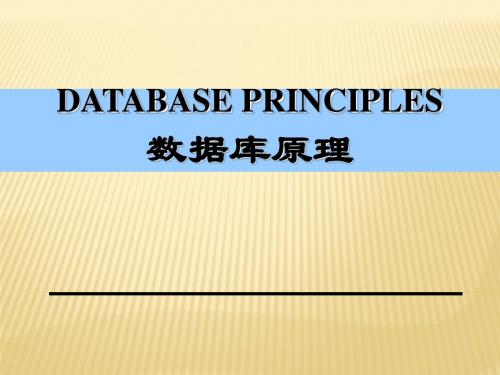
5
CHAPTER 1 THE WORLDS OF DATABASE SYSTEMS
•Evolution of Database Systems •Architecture of DBMS and DBS •Future of Database Systems
2
WHY USING ENGLISH TEXTBOOK ?
More computer English words More advanced and newest information Better information retrieval capability More international communication chance
1.1 EVOLUTION OF DATABASE SYSTEMS
1.1.1 Some Basic notions
Data Database (DB) Database Management System (DBMS) Database System (DBS). Database Administrator (DBA)
Database modeling
Relational model: theoretical background and operations
Database database management systems: transactions and security etc.
(database manager)
4
SYLLABUS
Background and history of database management systems
数据库系统概念(database system concepts)英文第六版 PPT 第18章
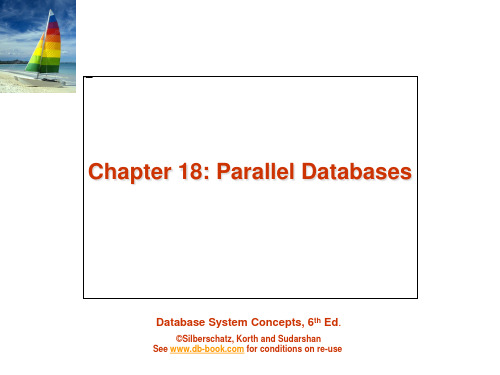
Database System Concepts - 6th Edition
18.4
©Silberschatz, Korth and Sudarshan
I/O Parallelism
Good for point queries on partitioning attribute
No clustering, so difficult to answer range queries
Database System Concepts - 6th Edition
18.9
©Silberschatz, Korth and Sudarshan
relational algebra)
makes parallelization easier.
Different queries can be run in parallel with each other.
Concurrency control takes care of conflicts.
Comparison of Partitioning Techniques (Cont.)
Range partitioning: Provides data clustering by partitioning attribute value. Good for sequential access Good for point queries on partitioning attribute: only one disk needs to
Introduction
数据库系统原理英文PPT课件

I/O system : drivers
memory controllers (i.e. disk controller),
on the basis of secondary storage’s physical structures, such as storage structures, access method
February 2011
7
第7页/共70页
§1.2 Purpose of Database Systems (cont.)
• Data management on the basis of file systems
• Example
— customer_record=<c_name, c_id, street, city> in Customer_File
February 2011
1
第1页/共70页
§1.0 DB, DBMS, DBS
• Definitions in the textbook • Database (DB) — a collection of interrelated data, stored in systems as files • Database management system (DBMS) — DB, or a collection of interrelated data — set of programs to access the data in DB
• Databases and DBS touch all aspects of our lives • Banking: all transactions • Airlines: reservations, schedules • Universities: registration, grades • Sales: customers, products, purchases • Manufacturing: production, inventory, orders, supply chain • Human resources: employee records, salaries, tax deductions
数据库系统概念(database system concepts)英文第六版 PPT 第11章

11.8
©Silberschatz, Korth and Sudarshan
Sparse Index Files (Cont.)
Compared to dense indices:
Less space and less maintenance overhead for insertions and deletions. Generally slower than dense index for locating records.
Database System Concepts - 6th Edition
11.3
©Silberschatz, Korth and Sudarshan
Index Evaluation Metrics
Access types supported efficiently. E.g.,
records with a specified value in the attribute or records with an attribute value falling in a specified range of values.
actual records with that particular search-key value.
Secondary indices have to be dense
Database System Concepts - 6th Edition 11.10 ©Silberschatz, Korth and Sudarshan
value in the file.
E.g. index on ID attribute of instructor relation
数据库系统概念(database system concepts)英文第六版 PPT 第17章
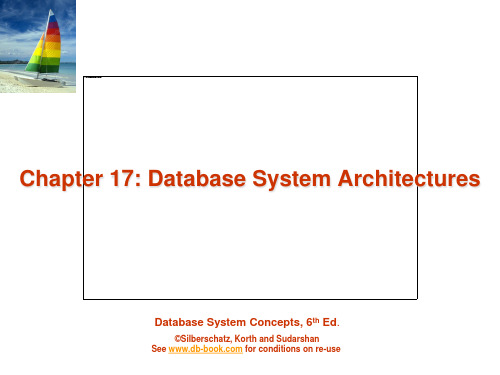
Database System Concepts - 6th Edition
17.3
© Silberschatz, Korth and Sudarshan
A Centralized Computer System
Database System Concepts - 6th Edition
17.4
© Silberschatz, Korth and Sudarshan
computer systems.
General-purpose computer system: one to a few CPUs and a number
of device controllers that are connected through a common bus that provides access to shared memory.
Checkpoint process
Performs periodic checkpoints
Monitors other processes, and takes recovery actions if any of the other processes fail
Process monitor process
Chapter 17: Database System Architectures
Centralized and Client-Server Systems Server System Architectures Parallel Systems Distributed Systems
better functionality for the cost flexibility in locating resources and expanding facilities better user interfaces easier maintenance
数据库系统概念(database system concepts)英文第六版 PPT 第24章
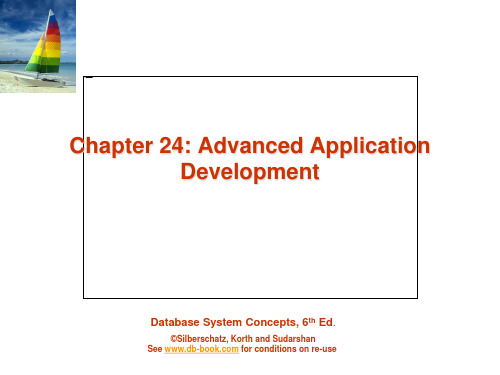
Solving above equation with current disk and memory prices leads to:
5-minute rule: if a page that is randomly accessed is used more frequently than once in 5 minutes it should be kept in memory
E.g., 80% of the code may take up 20% of time and 20% of code takes up 80% of time
Worth spending most time on 20% of code that take 80% of time
Bottlenecks may be in hardware (e.g., disks are very busy, CPU is
idle), or in software
Removing one bottleneck often exposes another
De-bottlenecking consists of repeatedly finding bottlenecks, and
removing them
This is a heuristic
24.2
©Silberschatz, Korth and Sudarshan
Performance Tuning
Adjusting various parameters and design choices to improve system performance for a specific application.
数据库系统概念(databasesystemconcepts)英文第六版-第四章精品PPT课件
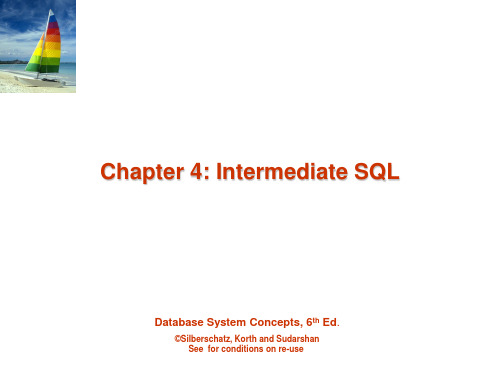
4.6
©Silberschatz, Korth and Sudarshan
Right Outer Join
n course natural right outer join prereq
Database System Concepts - 6th Edition
4.7
©Silberschatz, Korth and Sudarshan
Joined Relations
n Join operations take two relations and return as a result another relation.
n These additional operations are typically used as subquery expressions in the from clause
Database System Concepts - 6th Edition
4.5
©Silberschatz, Korth and Sudarshan
Left Outer Join
n course natural left outer join prereq
Database System Concepts - 6th Edition
n Join Expressions n Views n Transactions n Integrity Constraints n SQL Data Types and Schemas n Authorization
Database System Concepts - 6th Edition
4.2
n Join condition – defines which tuples in the two relations match, and what attributes are present in the result of the join.
数据库系统概念(database system concepts)英文第六版 PPT 第六章
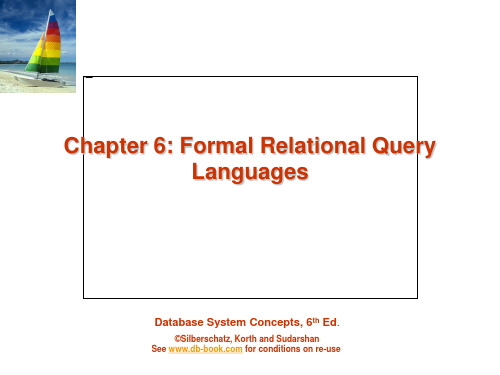
Database System Concepts - 6th Edition
6.8
©Silberschatz, Korth and Sudarshan
Union Operation
Notation: r s Defined as:
r s = {t | t r or t s}
©Silberschatz, Korth and Sudarshan
Cartesian-Product Operation – Example
Relations r, s:
r x s:
Database System Concepts - 6th Edition
6.12
©Silberschatz, Korth and Sudarshan
Project Operation
Notation:
A , A , , A 1 2 k
(r )
where A1, A2 are attribute names and r is a relation name.
The result is defined as the relation of k columns obtained by erasing
For r s to be valid.
1. r, s must have the same arity (same number of attributes) 2. The attribute domains must be compatible (example: 2nd column of r deals with the same type of values as does the 2nd column of s)
数据库系统概念(database system concepts)英文第六版 第一章
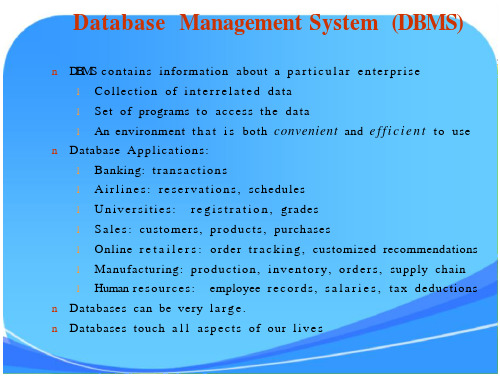
Relational Model
n R e l a t i o n a l model (Chapter 2)
• Columns
n Example of t a b u l a r d a t a i n t h e r e l a t i o n a l model
n Two c l a s s e s of languages l Procedural – u s e r s p e c i f i e s what d a t a i s r e q u i r e d and how t o get those data l Declarative (nonprocedural) – user specifies what data i s r e q u i r e d without s p e c i f y i n g how t o g e t those data
l Difficulty in accessing data 4 Need t o w r i t e a new program t o c a r r y out each new t a s k
l Data i s o l a t i o n — multiple f i l e s and formats l Integrity problems
l Concurrent access by multiple users 4 Concurrent access needed f o r performance 4 Uncontrolled concurrent accesses can lead to inconsistencies – Example: Two people reading a balance (say 100) and updating i t by withdrawing money (say 50 each) a t the same time
数据库系统概念(英文精编版.第六版)
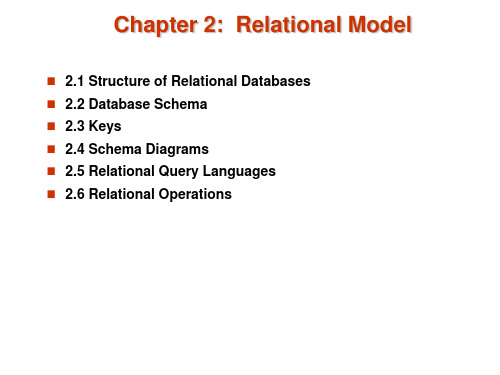
Attributes
Attribute Domain
The set of allowed values for each attribute is called the domain of the attribute
The special value null is a member of every domain
Instructor_schema = (ID, name, dept_name, salary)
r(R) is a relation on the relation schema R
We use lowercase names for relations.
Example: instructor (Instructor _schema)
2.5 Relational Query Languages
2.6 Relational Operations
Chapter 2: Relational Model
教学目的:
熟悉关系数据模型
教学重点:
简单属性、多值属性、复合属性
关系、关系模式、码等概念 关系模式图 关系代数的操作
?简单属性多值属性复合属性?关系关系模式码等概念?关系模式图?关系代数的操作?教学难点
Chapter 2: Relational Model
2.1 Structure of Relational Databases 2.2 Database Schema 2.3 Keys 2.4 Schema Diagrams
referenced relation
Exercise: 找出左图里面
存在的其他外码、参照关 系和被参照关系
数据库原理24学时英教ppt课件

– There may be many external schemas in a DB.
• Schema(模式): conceptual schema, logical schema
– Defines data from perspective systems designer;
– Independent of end users & data storage mechanism
?基本概念数据库的概念数据库管理系统的概念和功能数据库系统的概念和组成数据管理技术的发展?数据模型概念模型及er图表示方法数据模型的三大要素数据库领域中常用的数据模型关系模型的数据结构主要操作完整性约束?数据库系统结构数据库的三级模式结构体系结构数据独立性的概念及实现?关系数据库关系数据结构及形式化定义?域笛卡尔积关系主码外码关系模式关系代数运算符使用关系代数描述用户查询?sql语言sql语言的特点sql命令及使用?关系数据理论函数依赖等基本概念1nf2nf3nfbcnf的定义和判断关系模式设计不好可能出现的问题?数据库设计设计er图并转换为关系模式?事务事务的概念及特性?数据库恢复数据库恢复机制的功能故障种类及对数据库可能造成的影响恢复的实现技术备份日志?并发控制并发控制机制的功能并发调度的可串行性的定义封锁的概念?数据库安全性的概念及安全控制技术basicnotions?databasedbinessenceitsnothingmorethanacollectionofinformationthatexistsoveralongperiodoftime
Internal Schema Reflection, so application programs
needn’t been changed. 精选编辑ppt
数据库系统原理(英文)-6

6.2.1 Entity Sets (cont.)
A entity consists of all values of its all attributes e.g. Fig 6.1 Entity-set customer-set = {< ID-value, name-value, street - value, city -value> | ID-value ∈D1, name-value ∈D2, street -value∈D3, city -value D4} ⊆ D1 ╳ D2 ╳ D3 ╳ D4
603dbas生命周期模型需求分析概念设计逻辑设计物理设计性能存储安全需求数据项分析数据流与事务分析程序需求分析程序概要设计程序详细设计系统总体设计数据访问与处理应用程序数据组织与存储系统运行维护设计db概念模式设计db逻辑模式设计系统实现和部署事务详细设计db物理模式设计事务概要设计构造原型可选系统实现数据转换与加载系统测试部署与交付规划与分析项目规划运行维护中国移动网管支撑系统规范cmoss20性能指标要求621entitysets实体集实体型conceptualdatabasecanrelationshipamongentities
6.1 Overview of the Design Process (cont.)
数据库应用系统DBAS设计 DB, DBMS, users, application programs refer to Fig. 6.0.2 电信网管系统示意图 DBAS设计 refer to Fig. 6.0.3 DBAS 生命周期模型 参照软件工程中软件开发瀑布模型原理,DBAS的生命周 期由项目规划、需求分析、系统设计、实现与部署、运行 管理与维护等5个基本活动组成 根据DBAS的软件组成和各自功能,分为数据组织与存储 设计、数据访问与处理设计、应用设计三条设计主线,分 别用于设计数据库、数据库事务和应用程序
数据库系统概念(database system concepts)英文第六版 PPT 第五章
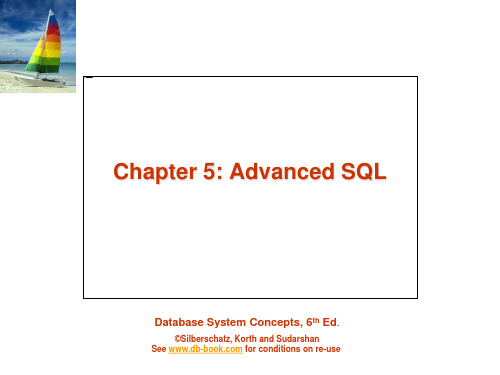
"select * from instructor where name = ‟" + name + "‟" Suppose the user, instead of entering a name, enters: X‟ or ‟Y‟ = ‟Y then the resulting statement becomes: "select * from instructor where name = ‟" + "X‟ or ‟Y‟ = ‟Y" + "‟" which is: select * from instructor where name = ‟X‟ or ‟Y‟ = ‟Y‟ User could have even used X‟; update instructor set salary = salary + 10000; - Prepared statement internally uses: "select * from instructor where name = ‟X\‟ or \‟Y\‟ = \‟Y‟ Always use prepared statements, with user inputs as parameters
How is this useful?
Database System Concepts - 6th Edition
5.10
©Silberschatz, Korth and Sudarshan
Metadata (Cont)
Database metadata DatabaseMetaData dbmd = conn.getMetaData();
《数据库原理》(双语)教学大纲_English

《Database Principles》Course Syllabus1、Course Number:0403052、Course Type: Optional-limitedCourse periods: 32 hours (Theoretical 24 / Practical 8)Supported Majors: Communication Engineering,Electronic and Information Engineering,Electronic Information Science and Technology,Information EngineeringPre-Course: Introduction to Computer Science,C Programming Language3、Course Quality and MissionDatabase technology has become the core technology and an important base of computer information systems and application systems. Database Principles is a backbone course of Computer Science & Engineering and other related disciplines. Through the study of theory and practice in this course, students should grasp the basic concept of database systems and basic theory. Besides, we should focused on the study of relations between the relevant content database system, use SQL proficiently, master the theories and methods of designing database, master basic skills of database systems operation and maintenance, understanding of database technology developments.4、Teaching Outlines and Periods4.1 The worlds of database system (2 hours)4.1.1 Data Management Technology and Development4.1.2 Basic Concept of Database System4.1.3 Architecture of Database System and Application System4.1.4 Contents of Database System4.2 Database Models (2 hours)4.2.1 Information Modeling Period4.2.2 Concept Model and Data Model4.2.3 Entity/Relationship Model4.3 Relational Data Model (4 hours)4.3.1 Foundation of Relational Model4.3.2 Methods of Transforming E-R Model to Relational Model4.3.3 Relation Decomposing Theories and Methods4.3.4 Data Dependence4.3.5 Database Design4.4 Relational Algebra (2 hours)4.4.1 Relational Algebra Languages4.4.2 Characteristics/operator/ expression of Relational Algebra4.5 Standard Relational Database Language: SQL (6 hours)4.5.1 Characteristics of SQL4.5.2 Data Definition Statements4.5.3 Data Query Statements4.5.4 Data Update Statements4.5.5 Definition and Use of View4.5.6 Data Control Method4.6 Transactions Management (2 hours)4.6.1 Concept and Characteristics of Transaction4.6.2 Database Recovery Technology4.6.3 Database Concurrency Control Technology4.7 Developing Platform and Tools (2 hours)4.7.1 Database Security and Control Method4.7.2 Integrality Constraints and Control4.8 Latest Database Technology (4 hours)4.8.1 Trend of Database System4.8.2 Application Fields of Database5、Basic Teaching RequirementsThe theoretical knowledge and practical ability of this course are both important, and has good application background. Through studying of theoretical and practical knowledge, the basic teaching requirements for the students are divided into three levels:5.1 Master: Belonging to the higher demand, the master of content should be more thorough understanding, can analysis and handle problems skillfully in the realenvironment.5.2Understand: Belonging to the general request, understand relevant content in-depth, can analysis and handle general issues5.3Know:Belonging to lower demand, understand the contents of the phenomenon in which the issues involved in, structures or related experiments.6、Main Teaching Contents6.1Grasp the concept of data management technology and its development process; master database , database management systems, database systems and other basic concept; grasp the characteristics of database system; grasp the concept of data models and the abstract processing of information modeling, understand and di stinguish ‘concept model’and ‘data model’; can describe the conceptual model using E/R graph; master popular database model and its characteristics; master relational model and related terms; master database structure, three-mode & two-mapping, and on the basis of this data independence guarantee, understand database system composition from the view of hardware, software and the user; understand the architecture of popular database application system.6.2Master the data structure of relational model, relational operation and integrity constraints; master the type of relational-data language; master formalized-definition in the view of set-theory, including concepts of domain, Cartesian plot, relationship, code, attributes, tuple, relational databases and so on; understand the relationship and distinction between relation and relational-mode; can describe queries sent by user using relational algebra language.6.3Master data definitions, data query, data update, the definition and query of view, data control statements; master embedded SQL and can embed SQL in C programming language; understand ODBC, JDBC interface.6.4Master standardized theory and the basic concept of data dependency; grasp the basic idea, the essence and purpose of standardization process; master the definition of 1 NF, 2NF, 3NF, BCNF paradigm, be able to judge which paradigm a relational-mode belong to.6.5Master features, basic steps and the mission of every design stage during database designing; establish the concept of software engineering; focus grasping the features, methods and results of concept-designing and logic-designing; master data abstract methods and can use E/R graph when describe entities, attributes, relationsand codes; master approach of converting E/R model into relation mode.6.6Grasp the concept and features of transactions; master the role of database recovery mechanism and the significance, as well as various types of failures and the possible impact to the database; master database recovery technology, such as data dump, log; master the database recovery strategy when fault is targeted.6.7Master and analysis the potential inconsistencies of database during concurrent operation; master the concept and significance of concurrent control; master the embargo-lock technology and protocols of concurrent control.6.8 Understand the concept and methods of database security and safety; understand the integrity constraints, integrity control mechanism and its implementation.6.9Learn new database technology (by teachers from the optional talk)7、Requirments on the Extra-curricular Work7.1 For TeachersIn principle, each knowledge point of the chapter should be consolidated by enabling students through the appropriate amount of exercise. Extra-curricular work can be designed like the forms of thinking, calculating, comprehensive-reporting and so on. Generally, thinking work has a theoretical depth, and is not necessarily to be submission, but should encourage students conducting in-depth thinking. The purpose of calculating work is to practice a certain point by the exercise. Comprehensive report is suitable for large-scale designing or developing project, and students can complete it in a team with submitting a formal report. The comprehensive training should focus on the students’ thinking, hands, collaborating and writing skills.The homework or the report must be marked within two weeks, and give explanation at the appropriate time.7.2 For StudentsStudents must complete and submit exercises within the specified time limit. Should be completed independently, give full play to individual initiative, positive thinking, no copying.8、The Relations between This Course and the Follow-up CoursesThis course mainly about the senior data management techniques, involving database-model analyzing, designing and application developing. The core part ofDatabase management system related to the data storage, indexing, query processing and optimization, buffer management, concurrency control, recovery and so on. Studying this course well means mastering the advanced data management techniques, and can be applied to various segments or areas where data management is needed. By the content of this course, it will closely related to other courses, such as the principle of compilers, computer networks, software engineering, advanced database technology, data warehousing, data mining, artificial intelligence, and so on.9、Requirements for the Ability of StudentsThis course will not only require students to study the theoretical knowledge hard, but also to take the initiative in the creation, practice in the real environment and application development. As there are lots of development environments, they can not be detail introduced in the classroom, which requires students to take the initiative to understand the market on commercial products and the skills of developing tools. Furthermore, in order to meet the goal of professional and opened-vision, we must improve the learning ability by increasing the use of English professionally with network platform and read the latest English literature.10、Reference books and teaching materials10.1 A First Course in Database Systems(second edition), Jeffrey D.Ullman,Jennifer Widom, China machine press, 2007.10.2 Database System Introduction(The 4th Edition). Wang Shan, Sa ShiXuan,High Education Press. 2006.10.3 Silberschatz, Korth and Sudarshan. Database System Concepts. ChinaMachine Press and McGraw-Hill. 1999.10.4 Patrick O’Neil and Elizabeth O’Neil, Principles, Programming, andPerformance. Higher Education Press and Morgan Kaufmann Publishers.2001.11、Teaching Methods and the Using of MediaAs there is quite a number of flexible and designing knowledge in this course, teaching methods need to be used in the course of heuristic, discussion-style. Students should be mobilized and think enthusiastically, and it is necessary to fully affirmed the innovation of students. As the relatively information of this course may be quite alarge amount, and also there will be a lot of text description information, we recommend the method of using multimedia equipment, together with writing on the blackboard. When it comes to the introduction of a database product or developing tools, the PPT files should be beautiful, intuitive courseware, so that the student s’ interest in learning can be fully exploded.12、Learning Methods and RecommendationsAs the contents of this course are mostly involved in the real application background, it will not be very abstract. However, the relevant knowledge can only be grasped to the essence after practicing, which can also help accumulating the corresponding development experience. So the learning process should combine the theory with practice. At the same time, we should also strive to raise the professional standard of English, particularly the listening and speaking ability.。
- 1、下载文档前请自行甄别文档内容的完整性,平台不提供额外的编辑、内容补充、找答案等附加服务。
- 2、"仅部分预览"的文档,不可在线预览部分如存在完整性等问题,可反馈申请退款(可完整预览的文档不适用该条件!)。
- 3、如文档侵犯您的权益,请联系客服反馈,我们会尽快为您处理(人工客服工作时间:9:00-18:30)。
– People or applications may try to update the same information at the same time.
• Record retention
– When information should be discarded
6-3
Chapter Objectives (Cont’d)
• Understand the nature of the tasks required for recovery using rollback/rollforward
• Know basic administrative and managerial DBA functions
• Before an operation is committed to the database, all LUWs must be successfully completed.
– If one or more LUW is unsuccessful, a rollback is performed and no changes are saved to the database.
levels • Understand the need for security and specific
tasks for improving database security • Know the difference between recovery via
reprocessing and recovery via rollback/rollforward
security, and backup and recovery • Learn about typical problems that can occur when
multiple users process a database concurrently • Understand the use of locking and the problem of
6-4
Heather Sweeney Designs
Database Design
5-5
Heather Sweeney Designs:
HSD Database in Microsoft SQL Server 2012
Figure 6-1: The HSD Database in Microsoft SQL Server 2012
inaccessible once a user touches the data.
– This ensures that data that is being considered for update is not shown.
• In the other extreme, data is always readable.
6-12
Transaction Example I
Figure 6-3: Comparison of the Results of Applying Serial Actions Versus a Multiple-Step Transaction
6-11
Need for Atomic Transactions
• A database operation typically involves several transactions.
• These transactions are atomic and are ห้องสมุดไป่ตู้ometimes called logical units of work (LUW).
6-6
Heather Sweeney Designs:
HSD Database Diagram in SQL Server 2012
6-7
The Database Processing Environment
Figure 6-2: The Database Processing Environment
Concurrency Control
• Concurrency control ensures that one user’s actions do not adversely impact another user’s actions.
• At the core of concurrency is accessibility. • In one extreme, data becomes
deadlock
6-2
Chapter Objectives (Cont’d)
• Learn the difference between optimistic and pessimistic locking
• Know the meaning of ACID transaction • Learn the four 1992 ANSI standard isolation
– The data is even readable when it is locked for update.
6-10
Concurrency Control (continued)
• Interdependency
– Changes required by one user may impact others.
Chapter Six
Database Administration
Chapter Objectives
• Understand the need for and importance of database administration
• Learn different ways of processing a database • Understand the need for concurrency control,
6-8
Control, Security and Reliability
• Three necessary database administration functions are:
– Concurrency control – Security – Backup and Recovery
6-9
